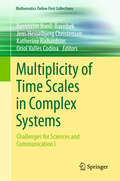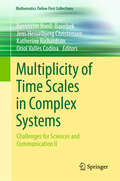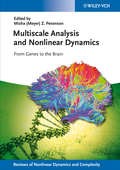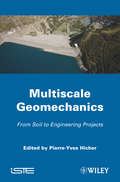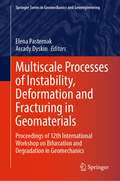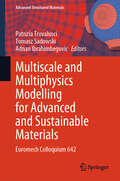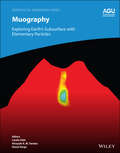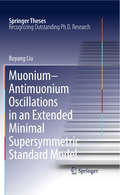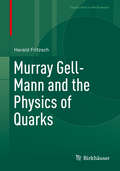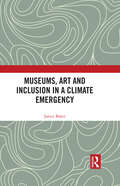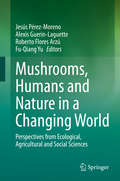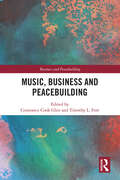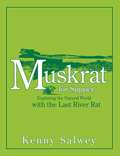- Table View
- List View
Multiple-point Geostatistics: Stochastic Modeling with Training Images
by Jef Caers Professor Gregoire MariethozThis book provides a comprehensive introduction to multiple-point geostatistics, where spatial continuity is described using training images. Multiple-point geostatistics aims at bridging the gap between physical modelling/realism and spatio-temporal stochastic modelling. The book provides an overview of this new field in three parts. Part I presents a conceptual comparison between traditional random function theory and stochastic modelling based on training images, where random function theory is not always used. Part II covers in detail various algorithms and methodologies starting from basic building blocks in statistical science and computer science. Concepts such as non-stationary and multi-variate modeling, consistency between data and model, the construction of training images and inverse modelling are treated. Part III covers three example application areas, namely, reservoir modelling, mineral resources modelling and climate model downscaling. This book will be an invaluable reference for students, researchers and practitioners of all areas of the Earth Sciences where forecasting based on spatio-temporal data is performed.
Multiplicity of Time Scales in Complex Systems: Challenges for Sciences and Communication I (Mathematics Online First Collections)
by Bernhelm Booß-Bavnbek Katherine Richardson Jens Hesselbjerg Christensen Oriol Vallès CodinaThis highly interdisciplinary volume brings together a carefully curated set of case studies examining complex systems with multiple time scales (MTS) across a variety of fields: materials science, epidemiology, cell physiology, mathematics, climatology, energy transition planning, ecology, economics, sociology, history, and cultural studies. The book addresses the vast diversity of interacting processes underlying the behaviour of different complex systems, highlighting the multiplicity of characteristic time scales that are a common feature of many and showcases a rich variety of methodologies across disciplinary boundaries. Self-organizing, out-of-equilibrium, ever-evolving systems are ubiquitous in the natural and social world. Examples include the climate, ecosystems, living cells, epidemics, the human brain, and many socio-economic systems across history. Their dynamical behaviour poses great challenges in the pressing context of the climate crisis, since they may involve nonlinearities, feedback loops, and the emergence of spatial-temporal patterns, portrayed by resilience or instability, plasticity or rigidity; bifurcations, thresholds and tipping points; burst-in excitation or slow relaxation, and worlds of other asymptotic behaviour, hysteresis, and resistance to change. Chapters can be read individually by the reader with special interest in such behaviours of particular complex systems or in specific disciplinary perspectives. Read together, however, the case studies, opinion pieces, and meta-studies on MTS systems presented and analysed here combine to give the reader insights that are more than the sum of the book’s individual chapters, as surprising similarities become apparent in seemingly disparate and unconnected systems. MTS systems call into question naïve perceptions of time and complexity, moving beyond conventional ways of description, analysis, understanding, modelling, numerical prediction, and prescription of the worldaround us. This edited collection presents new ways of forecasting, introduces new means of control, and – perhaps as the most demanding task – it singles out a sustainable description of an MTS system under observation, offering a more nuanced interpretation of the floods of quantitative data and images made available by high- and low-frequency measurement tools in our unprecedented era of information flows.
Multiplicity of Time Scales in Complex Systems: Challenges for Sciences and Communication II (Mathematics Online First Collections)
by Bernhelm Booß-Bavnbek Katherine Richardson Jens Hesselbjerg Christensen Oriol Vallès CodinaNote to the interested reader to have a look at the companion to this volume Challenges for Sciences and Communication I | ISBN: 978-3-031-28048-1.This highly interdisciplinary volume brings together a carefully curated set of case studies examining complex systems with multiple time scales (MTS) across a variety of fields: materials science, epidemiology, cell physiology, mathematics, climatology, energy transition planning, ecology, economics, sociology, history, and cultural studies. The book addresses the vast diversity of interacting processes underlying the behaviour of different complex systems, highlighting the multiplicity of characteristic time scales that are a common feature of many and showcases a rich variety of methodologies across disciplinary boundaries. Self-organizing, out-of-equilibrium, ever-evolving systems are ubiquitous in the natural and social world. Examples include the climate, ecosystems, living cells, epidemics, the human brain, and many socio-economic systems across history. Their dynamical behaviour poses great challenges in the pressing context of the climate crisis, since they may involve nonlinearities, feedback loops, and the emergence of spatial-temporal patterns, portrayed by resilience or instability, plasticity or rigidity; bifurcations, thresholds and tipping points; burst-in excitation or slow relaxation, and worlds of other asymptotic behaviour, hysteresis, and resistance to change. Chapters can be read individually by the reader with special interest in such behaviours of particular complex systems or in specific disciplinary perspectives. Read together, however, the case studies, opinion pieces, and meta-studies on MTS systems presented and analysed here combine to give the reader insights that are more than the sum of the book’s individual chapters, as surprising similarities become apparent in seemingly disparate and unconnected systems. MTS systems call into question naïve perceptionsof time and complexity, moving beyond conventional ways of description, analysis, understanding, modelling, numerical prediction, and prescription of the world around us. This edited collection presents new ways of forecasting, introduces new means of control, and – perhaps as the most demanding task – it singles out a sustainable description of an MTS system under observation, offering a more nuanced interpretation of the floods of quantitative data and images made available by high- and low-frequency measurement tools in our unprecedented era of information flows.
Multiscale Analysis and Nonlinear Dynamics
by Heinz Georg Schuster Misha Meyer PesensonSince modeling multiscale phenomena in systems biology and neuroscience is a highly interdisciplinarytask, the editor of the book invited experts in bio-engineering, chemistry, cardiology, neuroscience,computer science, and applied mathematics, to provide their perspectives. Each chapter is a window into the current state of the art in the areas of research discussed and the book is intended for advanced researchers interested in recent developments in these fields. While multiscaleanalysis is the major integrating theme of the book, its subtitle does not call for bridging thescales from genes to behavior, but rather stresses the unifying perspective offered by the conceptsreferred to in the title. It is believed that the interdisciplinary approach adopted here will be beneficial for all the above mentioned fields.
Multiscale Analysis of Viscous Flows in Thin Tube Structures (Advances in Mathematical Fluid Mechanics)
by Konstantin Pileckas Grigory PanasenkoThis book presents the analysis of viscous flows in thin tube structures, and develops a multi-scale method for modeling blood flow. For the reader’s convenience, the authors introduce all necessary notions and theorems from functional analysis and the classical theory of the Navier-Stokes equations. The problems of all asymptotic methods used in the book are explained as well, such as the dimension reduction and the boundary layer method. Through several numerical experiments, readers will discover that the proposed methods are more flexible than the theoretically predicted conditions. Multiscale Analysis of Viscous Flows in Thin Tube Structures will be a valuable resource for a wide range of readers, including applied mathematicians, specialists in bio-engineering, and biophysicists.
Multiscale Geographically Weighted Regression: Theory and Practice
by A. Stewart Fotheringham Taylor M. Oshan Ziqi Li· Provides a balance between conceptual and technical introduction to local models · Explains state-of-the-art spatial analysis technique for multiscale regression modeling · Describes best practices and provides a detailed walkthrough of freely available software, through examples and comparisons with other common spatial data modeling techniques · Includes a detailed case study to demonstrate methods and software · Takes a new and exciting angle on local spatial modeling using MGWR, an innovation to the previous local modeling ‘bible’ GWR
Multiscale Geomechanics: From Soil to Engineering Projects (Wiley-iste Ser.)
by Pierre-Yves HicherThis book addresses the latest issues in multiscale geomechanics. Written by leading experts in the field as a tribute to Jean Biarez (1927-2006), it can be of great use and interest to researchers and engineers alike. A brief introduction describes how a major school of soil mechanics came into being through the exemplary teaching by one man. Biarez's life-long work consisted of explaining the elementary mechanisms governing soil constituents in order to enhance understanding of the underlying scientific laws which control the behavior of constructible sites and to incorporate these scientific advancements into engineering practices. He innovated a multiscale approach of passing from the discontinuous medium formed by individual grains to an equivalent continuous medium. The first part of the book examines the behavior of soils at the level of their different constituents and at the level of their interaction. Behavior is then treated at the scale of the soil sample. The second part deals with soil mechanics from the vantage point of the construction project. It highlights Biarez's insightful adoption of the Finite Element Codes and illustrates, through numerous construction examples, his methodology and approach based on the general framework he constructed for soil behavior, constantly enriched by comparing in situ measurements with calculated responses of geostructures.
Multiscale Processes of Instability, Deformation and Fracturing in Geomaterials: Proceedings of 12th International Workshop on Bifurcation and Degradation in Geomechanics (Springer Series in Geomechanics and Geoengineering)
by Elena Pasternak Arcady Dyskin· Proceedings of 12th International Workshop on Bifurcation and Degradation in Geomechanics (IWBDG2022) held on 28 November - 1 December 2022 at the University of Western Australia, in Perth, Australia. The book concentrates on deep understanding of the processes of bifurcation and instability in geoengineering systems. The book covers multiscale processes from the scale of crystals to rocks to rock masses. The book considers a wide range of accompanying phenomena from liquefaction to seismicity and landslides. · Topics covered are: I. Localisation and instability in geomaterials II. Fracturing, failure and seismicity III. Deformation processes Intended readership: Universities and Consulting and Research organisations, research students, academics and engineers working in the fields of geomechanics, rock mechanics and geotechnical engineering.
Multiscale Seismic Tomography
by Dapeng ZhaoThis book on multiscale seismic tomography, written by one of the leaders in the field, is suitable for undergraduate and graduate students, researchers, and professionals in Earth and planetary sciences who need to broaden their horizons about seismotectonics, volcanism, and interior structure and dynamics of the Earth and Moon. It describes the state-of-the-art in seismic tomography, with emphasis on the new findings obtained by applying tomographic methods in local, regional, and global scales for understanding the generating mechanism of large and great earthquakes such as the 2011 Tohoku-oki earthquake (Mw 9. 0), crustal and upper mantle structure, origin of active arc volcanoes and intraplate volcanoes including hotspots, heterogeneous structure of subduction zones, fate of subducting slabs, origin of mantle plumes, mantle convection, and deep Earth dynamics. The first lunar tomography and its implications for the mechanism of deep moonquakes and lunar evolution are also introduced.
Multiscale and Multiphysics Flow Simulations of Using the Boltzmann Equation: Applications to Porous Media and MEMS
by Jun LiThis book provides a comprehensive introduction to the kinetic theory for describing flow problems from molecular scale, hydrodynamic scale, to Darcy scale. The author presents various numerical algorithms to solve the same Boltzmann-like equation for different applications of different scales, in which the dominant transport mechanisms may differ. This book presents a concise introduction to the Boltzmann equation of the kinetic theory, based on which different simulation methods that were independently developed for solving problems of different fields can be naturally related to each other. Then, the advantages and disadvantages of different methods will be discussed with reference to each other. It mainly covers four advanced simulation methods based on the Boltzmann equation (i.e., direct simulation Monte Carlo method, direct simulation BGK method, discrete velocity method, and lattice Boltzmann method) and their applications with detailed results. In particular, many simulations are included to demonstrate the applications for both conventional and unconventional reservoirs. With the development of high-resolution CT and high-performance computing facilities, the study of digital rock physics is becoming increasingly important for understanding the mechanisms of enhanced oil and gas recovery. The advanced methods presented here have broad applications in petroleum engineering as well as mechanical engineering , making them of interest to researchers, professionals, and graduate students alike. At the same time, instructors can use the codes at the end of the book to help their students implement the advanced technology in solving real industrial problems.
Multiscale and Multiphysics Modelling for Advanced and Sustainable Materials: Euromech Colloquium 642 (Advanced Structured Materials #231)
by Patrizia Trovalusci Tomasz Sadowski Adnan IbrahimbegovicThis book offers the proceedings of Euromech colloquium 642, which wanted to provide a forum to present and debate several advanced computational, experimental, and analytical methods for studying the behaviour of complex materials and structures. The goal was to gather researchers (engineers, physicists, and mathematicians) specialized in multiscale material modelling for simulating the mechanics of solids and the physics of matter with the final aim of bridging the gap between solids and structural mechanics and material science in the modelling of “complex” materials. Both computational and experimental aspects play a central role, and talks have also focused on a broad range of aspects either related to the material modelling or the structural one. Various types of complex materials, made of very different constituents, are used nowadays in engineering practice: particle or fibrous composites; laminates; green composites with natural fillers and industrial or urban recyclable materials; nanomaterials; architecture material; in general complex multiphase materials with a complex internal structure including: porosity, reinforcement in the form of short fibres and particles of various properties, shapes, and sizes, filled in different media. It is widely recognized that important macroscopic properties such as the macroscopic stiffness and strength are governed by multiphysics processes (e.g. damage due to heat transfer or fluid penetration, crack propagation under thermal shock in ceramic/metallic matrix composites, etc.) which occur at one to several scales below the level of observation. A thorough understanding of how these processes influence the reduction of stiffness and strength is a key to the analysis of existing, and the design of improved, complex materials. The colloquium was centred on “Multiscale and Multiphysics Modeling of Complex Materials”, with attention to the constitutive aspects concerning complex materials, so defined for the presence of internal structure at different scales (nano/micro/meso) and nonlinear constitutive behaviour (plasticity, damage, fracture, etc.).
Multitemporal Remote Sensing: Methods and Applications (Remote Sensing and Digital Image Processing #20)
by Yifang BanWritten by world renowned scientists, this book provides an excellent overview of a wide array of methods and techniques for the processing and analysis of multitemporal remotely sensed images. These methods and techniques include change detection, multitemporal data fusion, coarse-resolution time series processing, and interferometric SAR multitemporal processing, among others. A broad range of multitemporal datasets are used in their methodology demonstrations and application examples, including multispectral, hyperspectral, SAR and passive microwave data. This book features a variety of application examples covering both land and aquatic environments. Land applications include urban, agriculture, habitat disturbance, vegetation dynamics, soil moisture, land surface albedo, land surface temperature, glacier and disaster recovery. Aquatic applications include monitoring water quality, water surface areas and water fluctuation in wetland areas, spatial distribution patterns and temporal fluctuation trends of global land surface water, as well as evaluation of water quality in several coastal and marine environments.This book will help scientists, practitioners, students gain a greater understanding of how multitemporal remote sensing could be effectively used to monitor our changing planet at local, regional, and global scales.
Multiuse Wetlands Governance: Challenges and Institutional Choices
by Dinesh K. MarothiaThe Ramsar Convention was established in 1971 to ensure the conservation and wise use of wetlands across the world. India joined the Convention in 1982, however, in the past 50 years despite Ramsar’s incredible achievements, the threat to wetlands across the globe, including India, has not diminished. This book studies the governance of multiuse wetlands in India. The volume provides an exhaustive analysis of rural, peri-urban and urban human-made wetlands to establish the relevance of institutional design and the effective role of authority in governing multiuse wetland ecosystem services. The author argues that the most challenging task in governing wetlands is to frame institutional choices that users and non-users comprehend, and agree to pursue under alternative property rights regimes. Drawing on extensive fieldwork, the book provides a broader look into the causes and consequences of wetland ecosystem degradation and offers insights into improved sustainable management systems for different types of multiuse wetlands. It will be indispensable for students and researchers of environmental studies, sustainable development, biodiversity, conservation, agricultural, natural, and environmental resource economics.
Municipal Landfill Leachate Management (Environmental Science and Engineering)
by Maryam Pazoki Reza GhasemzadehThis book is divided into seven chapters, which address various leachate landfill management issues such as the quality, quantity and management of municipal landfill leachate, together with new methods. There are many methods available for the treatment and management of municipal landfill leachate. The waste management methods presented here can be applied in most third-world countries, due to the lack of waste separation and high organic content of waste. The book provides descriptions and a hierarchy of waste management, reviews the history of solid waste disposal, and covers a range of topics, including: leachate and gas generation in landfills; natural attenuation landfills; landfill site selection; leachate and stormwater management, collection and treatment; landfill gas management; landfill cover requirements; leachate collection; types of natural treatment systems; and design procedure and considerations. In closing, it provides an overview of the current solid waste management status in Iran.
Muography: Exploring Earth's Subsurface with Elementary Particles (Geophysical Monograph Series)
by László Oláh Hiroyuki K. M. Tanaka Dezső VargaMuography Muography Exploring Earth’s Subsurface with Elementary Particles Hidden out of sight in Earth’s subsurface are a range of geophysical structures, processes, and material movements. Muography is a passive and non-destructive remote sensing technique that visualizes the internal structure of solid geological structures at high resolution, similar in process to X-ray radiography of human bodies. Muography: Exploring Earth’s Subsurface with Elementary Particles explores the application of this imaging technique in the geosciences and how it can complement conventional geophysical observations. Volume highlights include: Principles of muography and pioneering works in the field Different approaches for muographic image processing Observing volcanic structures and activity with muography Using muography for geophysical exploration and mining engineering Potential environmental applications of muography Latest technological developments in muography The American Geophysical Union promotes discovery in Earth and space science for the benefit of humanity. Its publications disseminate scientific knowledge and provide resources for researchers, students, and professionals.
Muonium-antimuonium Oscillations in an Extended Minimal Supersymmetric Standard Model
by Boyang LiuThis innovative work investigated two models where the muonium-antimuonium oscillation process was mediated by massive Majorana neutrinos and sneutrinos. First, we modified the Standard Model only by the inclusion of singlet right-handed neutrinos and allowing for general renormalizable interactions producing neutrino masses and mixing. The see-saw mechanism was employed to explain the smallness of the observed neutrino masses. A lower bound on the righthanded neutrino mass was constructed using the experimental limits set by the nonobservation of the muonium-antimuonium oscillation process. Second, we modified the Minimal Supersymmetric Standard Model by the inclusion of three right-handed neutrino superfields. The experimental result of the muonium-antimuonium oscillation process generated a lower bound on the ratio of the two Higgs field VEVs. This work helps to set up relationships between the experimental result of the muonium-antimuonium oscillation process and the model parameters in two specific models. Further improvement of the experiment in the future can generate more stringent bounds on the model parameters using the procedure developed by this work.
Murray Gell-Mann and the Physics of Quarks (Classic Texts in the Sciences)
by Harald FritzschMurray Gell-Mann, Physics Nobel Prize Laureate in 1969 is known for his theoretical work on elementary particle physics and the introduction of quarks and together with H. Fritzsch the “Quantum Chromodynamics”. Based on four sections the Editor gives an overview on the work of Gell-Mann and his contributions to various aspects of the physics, related to quarks. His most important and influential papers were selected and reprinted so that the reader easily can check the original work of Gell-Mann.
Murray: A River And Its People
by Paul SinclairThe Murray River is in crisis, and faces an uncertain future. In this evocative book, Paul Sinclair explores the reasons why the river has become degraded, and what these changes have meant to Australians. This in-depth study of the Murray River examines the changing cultural meanings of the river: the practical forgetfulness which has eroded the Aboriginal presence; the triumphant narratives in which a supposedly empty land is made purposeful by the life-giving powers of the Murray; the passion to make the river's flow predictable and to replace 'primitive' forces with a domesticated and balanced landscape. The focus is on shifts and changes. Sinclair describes the brief heyday of the riverboats and their transformation into a tourist attraction; the decline of the mighty Murray cod and the rise of the European carp; and the changing fortunes of the river towns. He demonstrates that 'progress' is often a myth, and that ecological degradation always has cultural costs. This is an innovative cultural and environmental history, about landscape and fish, memory and concepts, imagination and desire. Through a complex interweaving of history, analysis, poetry, art, and individuals' recollections, Paul Sinclair has created an original and subtly conceived work, offering imaginative space to think about land and water in new ways. Fishermen, farmers, tourists, environmentalists, lovers of the Australian landscape—all these people will want to read this beautifully written book. It will be an essential resource for those directly involved in the future of the Murray River, contributing to the larger debate about Australia's threatened environment.
Museum Practices and the Posthumanities: Curating for Planetary Habitability (Routledge Environmental Humanities)
by Fiona R. CameronThis book critiques modern museologies and curatorial practices that have been complicit in emerging existential crises. It confidently presents novel, more-than-human curatorial visions, methods, frameworks, policies, and museologies radically refiguring the epistemological foundations of curatorial, museological thinking, and practice for a habitable planet. Modern curatorial and museological practices are dominated by modern humanism in which capital growth, social, technological advancement, hubris, extraction, speciest logics, and colonial domination predominate, often without reflection. While history, science, and technology museums and their engagement with non-human worlds have always been ecological as an empirical reality, the human-centred frameworks and forms of human agency that institutions deploy tend to be non-cognizant of this reality. Museum Practices and the Posthumanities: Curating for Planetary Habitability reveals how these practices are ill-equipped to deal with the contemporary world of rapid digital transformations, post-Covid living, climate change, and its impacts among other societal changes, and it shows how museums might best meet these challenges by thinking with and in more-than-human worlds. This book is aimed at museological scholars and museum professionals, and it will provide them with the inspiration to conduct research on and curate from a different ecological reference point to promote a world good enough for all things to thrive in radical co-existence.
Museums and the Climate Crisis
by Nick MerrimanMuseums and the Climate Crisis shows how museums can respond to the interrelated global climate, biodiversity and pollution crises. They have a unique role because they take a long-term perspective, and their scholarship and independence mean that they remain trusted by the public. Providing insights and international case studies from a range of museum and gallery professionals, academics and consultants, this book explores how museums can use this unique perspective to engage the public as active citizens, and how they are exemplars of good practice in areas such as emissions reduction and encouraging biodiversity. It shows how museums can combat climate exhaustion by drawing on understandings about positive motivation, and how to develop exhibitions, events and activities that motivate visitors to take action. Taking a broad approach beyond purely climate issues, the contributions touch on the use of renewables, environmental controls and standards, travel (including virtual couriering), waste management (including recycling, plastic reduction and composting), reducing pollution and increasing biodiversity within museums. Museums and the Climate Crisis will be important reading to those studying in the fields of Museum Studies, Heritage Studies and Conservation. Taking a practical approach, it will also be beneficial to museum, gallery and heritage professionals who are grappling with the challenges of the climate crisis.
Museums, Art and Inclusion in a Climate Emergency
by Janice BakerMuseums, Art and Inclusion in a Climate Emergency considers the impact of the Anthropocene on history and memory, approaches to objects and agency and the incommensurability of western and Indigenous ontologies. Drawing on Indigenous knowledge, humanities and museological literature, continental philosophy, contemporary art and popular culture, Baker acknowledges the autonomous agency of geological forms, including soils, minerals and fossil fuels. Demonstrating that this has implications for an expanded idea of an ‘inclusive’ museum and its relationship to entities beyond ‘life’ and living species, the book argues that the ‘inclusion’ paradigm needs to include nonlife actors. Gesturing to a geontological ‘turn’ through developing notions of geo-inclusion, the mineralhuman and approaches to object agency that connect with Aboriginal ‘heritage’, Baker exposes the ongoing destruction of Country by mining interests in Western Australia and elsewhere. By addressing the need for urgent change through the artifice of the museum, the book identifies an expanded approach to inclusion beyond the limits imposed by the politics of identity. Museums, Art and Inclusion in a Climate Emergency theorises the potential of an expanded idea of the museum and will be of interest to scholars and students engaged in the study of museums and heritage, environmental humanities and geo-humanities, ecological art history and contemporary art.
Mushrooms of Hawai'i: An Identification Guide
by Dennis E. Desjardin Don E. HemmesHawai'i is known for its verdant mountains and colorful ocean ecosystems, but few realize the depth and range of the islands' mushroom diversity. In fact, Hawai'i is home to over 230 species of mushrooms that are prized by foragers from around the world. In Mushrooms of Hawai'i, Don Hemmes and Dennis Desjardin present a beautiful and comprehensive guide to the treasure trove of mycological life in the Aloha State. Inside you'll find information on Mushroom identification Culinary and medicinal uses of Hawaiian mushrooms Where to find the best mushroom-hunting spots The seasonality of Hawaiian mushrooms And everything else you might need to make your foraging adventure a success. Mushrooms of Hawai'i also includes beautiful illustrations to help you identify familiar treasures like morels, well-known dangers like Amanita muscaria, and exciting species unique to the islands. Whether you're hunting Copelandia cyanescens ("magic" mushrooms) in the pasture grasses high in the mountains of Maui, or foraging for Laetiporus (chicken of the woods), an edible mushroom sought after by foodies for its uniquely delicious taste, this book is the must-have guide for fungophiles.
Mushrooms, Humans and Nature in a Changing World: Perspectives from Ecological, Agricultural and Social Sciences
by Jesús Pérez-Moreno Alexis Guerin-Laguette Roberto Flores Arzú Fu-Qiang YuThis book focuses on recent advances in our understanding of wild edible mycorrhizal fungi, truffle and mushrooms and their cultivation. In addition to providing fresh insights into various topics, e.g. taxonomy, ecology, cultivation and environmental impact, it also demonstrates the clear but fragile link between wild edible mushrooms and human societies. Comprising 17 chapters written by 41 experts from 13 countries on four continents, it enables readers to grasp the importance of protecting this unique, invaluable, renewable resource in the context of climate change and unprecedented biodiversity loss. The book inspires professionals and encourages young researchers to enter this field to develop the sustainable use of wild edible mushrooms using modern tools and approaches. It also highlights the importance of protecting forested environments, saving species from extinction and generating a significant income for local populations, while keeping alive and renewing the link between humans and wild edible mushrooms so that in the future, the sustainable farming and use of edible mycorrhizal mushrooms will play a predominant role in the management and preservation of forested lands.
Music, Business and Peacebuilding (Business and Peacebuilding)
by Timothy L. Fort Constance Cook GlenBusiness schools are placing more emphasis on the role of business in society. Top business school accreditors are shifting to mandating that schools teach their students about the social impact of business, including AACSB standards to require the incorporation of business impact on society into all elements of accredited institutions. Researchers are also increasingly focused on issues related to sustainability, but in particular to business and peace as a field. A strong strain of scholarship argues that ethics is nurtured by emotions and through aesthetic quests for moral excellence. The arts (and music as shown specifically in this book) can be a resource to nudge positive emotions in the direction toward ethical behavior and, logically, then toward peace. Business provides a model for positive interactions that not only foster long-term successful business but also incrementally influences society. This book provides an opportunity for integration and recognition of how music (and other art forms) can further encourage business toward the direction of peace while business provides a platform for the dissemination and modeling of the positive capabilities of music toward the aims of peace in the world today. The primary market for this book is the academic audience. Unlike many other academic books, however, the interdisciplinary nature of the book allows for multiple academic audiences. Thus, this book reaches into schools of music, business, political science, film studies, sports and society studies, the humanities, ethics and, of course, peace studies.
Muskrat for Supper
by Kenny SalweyMuskrat for Supper inspires young people to explore nature's life cycles and understand the concept of the circle of life, as told through the tale of a family that embarks on a hunting and trapping adventure. It is an endearing story that weaves together such themes as sustainable living, our natural environment, and living closer to nature. The first book for children by this acclaimed storyteller and author, Muskrat for Supper includes questions young people have asked Kenny Salwey about his lifestyle as a river rat living off the land. The story will be illustrated with black-and-white photographs as well as nonfiction material to supplement the text. Kenny Salwey is the last of a breed of men whose lifestyle has all but disappeared in this fast-paced, high-tech digital world. For thirty years, this weathered woodsman eked out a living on the Mississippi River running a trapline, hiring out as a river guide, digging and selling roots and herbs, and eating the food he hunted and fished. Today Salwey is a master storyteller, environmental educator, keynote speaker, nature writer, and advocate for the Upper Mississippi River. He has presented his true-life adventures and words of natural world wisdom to both adult and young audiences across the upper Midwest. By sharing his hard-learned experiences, his respect for the Mississippi River, and his love of the natural world, Salwey hopes to inspire his audiences to protect this precious and fragile ecosystem.

